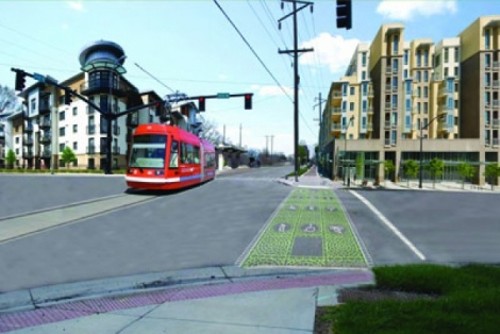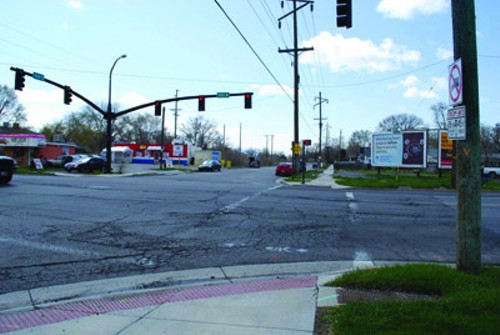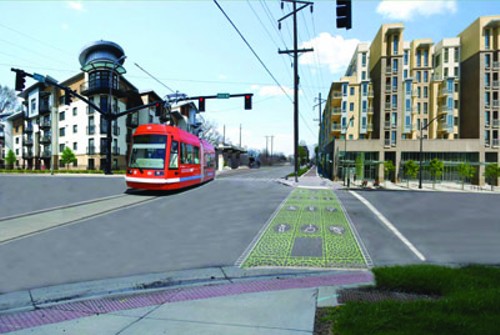Residents of west Salt Lake City have been known to fume as they see new shopping centers, national chains, fine dining and other city improvements materialize in other parts of town. “We’ve been neglected for 35, 40 years,” says Randy Sorensen, chair of the Glendale Community Council. “It’s a different administration but the same old song,” he says, clearly exasperated. “They talk big and then nothing ever happens.”
But with airport TRAX construction and a North Temple facelift, the winds may be shifting for the west side. The Salt Lake City Planning Commission is in the process of creating what assistant planner Elizabeth Reining calls a “blueprint for the community” for what some see as the city’s poorest, more isolated and historically neglected areas. Reining and principal planner Nick Britton are making the rounds to community council meetings and forums to present possibilities and receive input on land use, zoning and development issues. Planners hope to present the final draft to the community in early fall, when it will almost certainly become a political football in the election for District 2’s City Council seat.
Likely because of residents’ frustration, interest in that council seat is keen. Even though filing for this November’s election will not open until July, signs with the council candidates’ names already dot the neighborhood. Three candidates have declared their intention to run: incumbent Van Turner; Michael Clara, Poplar Grove community council secretary and local activist; and People’s Market founder Kyle LaMalfa. All care deeply about their neighborhood, but each has a different vision of how to approach the master planning process—and how to deal with a city government that many residents feel has left them neglected.
The neglect, however, is not strictly due to a lack of a plan. The first West Salt Lake Master Plan—which includes Glendale, Poplar Grove and Euclid neighborhoods—was adopted in 1995. It set out to rehabilitate and develop residential, commercial and industrial zones from Interstate 15 in the east to Bangerter Highway in the west and from the 2100 South Expressway to just north of North Temple. Back then, the goals looked much the same as they do today: neighborhood revitalization, increased public transit, improved bike and pedestrian thoroughfares and development of the Jordan River Parkway.
Salt Lake City’s Britton traces the lack of progress to the plan’s unspecific, broadly defined goals and a lack of coordination between the zoning and planning commissions. He also points out that the plan has always been intended as a long-term vision, and “there hasn’t been enough time passing [for development].” He suggests this is because, previously, development was left up to developers. “You need the private sector, not just the city and government” to invest in revitalization, he says.
Clara tells a different story. While he proclaims respect for Turner, he believes that the incumbent “doesn’t advocate for [neighborhood] issues.” Clara says Turner has downplayed the gang problem and almost let a freight train run on 900 South, through the heart of his community. LaMalfa agrees that while Turner has “done a lot of good,” he thinks he could do better in “leveraging the office to do more than vote yes or no.”
Turner, a lifelong resident of Glendale running for his fourth term as council member, says there’s been a delay on almost all of the city’s master plans because of both the political and monetary capital that must be raised. Plus, he says, “We’ve had a lot of catching up to do” before moving on to the master plan. He cites updated infrastructure, such as improved lighting and updated water lines, as evidence that he’s been working hard for his district. For every project he undertakes, Turner must not only get the support of the mayor and other council members, but also must find money within the budget or apply for grants at the federal and state level.
Community input for the master plan is vital, but planners say turnout at meetings has been lackluster. Britton estimates 50 community members showed up to the first meeting in January, and numbers fell to less than half of that at the following meeting in April.
So far, though, public comment has followed a few major themes: a more pedestrian and bicycle-friendly Redwood Road, better transit connections to the rest of the city and protection of open spaces, including the Jordan River Parkway. There’s also talk of a retail and commercial hub at 900 West and 900 South, geographically mirroring the intersection of 900 East and 900 South but imbued with the west side’s multicultural character. This intersection will correlate with a proposed bike lane along 900 South, slated for installation this summer.
The current 900 West and 900 South intersection:
A rendition of the intersection with "significant" development:
Residents are also passionate about dispelling the myth about “the wrong side of the tracks.”
“We’re not the most politically affluent area,” admits Mike Harman, former chair of the Poplar Grove community council. Even so, he admits, “Oftentimes, we get neglected because we don’t advocate for ourselves.”
Clara, a member of the mayor’s anti-gang taskforce, is vocal about his neighborhood’s crime problem, but lauds community efforts to prevent gang recruitment and to help present members escape gang life.
Detective Bret Hatch of Pioneer Precinct in District 2 disagrees: “It’s just a perception. … I found that I have the same problem with gangs on the east side as I have on the west side.” Andrew Johnston, community chair for Poplar Grove, thinks the perception stems from “a lot of visible crime.” “I worry that perception creates reality,” he confesses, “If we think that [the west side] is where crime happens, we’re going to push it that way.”
LaMalfa believes the planning commission should be making more of an effort to spread the word to west Salt Lake. “Communication is a weak point,” LaMalfa says. He wants to see a more pervasive campaign in multiple languages to draw in a larger swath of the community. Turner feels that between public meetings, the Internet and phone service, opportunities to comment are plentiful. Clara emphasizes, “There’s opportunities at every step to oppose or support [the master plan.]” Even after the final draft is presented to the community and sent to the City Council, the master plan will be open for public comment.
“It’s not our job to tell people what the vision [for west Salt Lake City] is,” Britton says. “It’s our job to listen.”
For information on future meetings, visit the planning commission’s site for west Salt Lake City (WestSaltLake.com), where you can review documents including summaries of past meetings and the original 1995 master plan. Residents of all neighborhoods are invited to Salt Lake City’s online forum, Open City Hall (SLCGov.com/OpenCityHall), to share ideas for the master plan.
More by Sarah Kramer
-
Women's Night at the Bicycle Collective
Demand has grown for ladies-only time to learn about and work on bikes
- Feb 19, 2014
-
Mike Doughty at Urban Lounge
- Nov 1, 2013
-
The Moth & the Flame
Provo's The Moth & the Flame release EP and prepare for international tour
- Oct 24, 2013
- More »
Latest in News
Readers also liked…
-
Raise a glass for E.L.T Harrison, architect of the Beerhive building on Main
Small Lake City
- Oct 11, 2023






